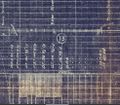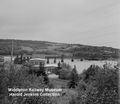Dominion Atlantic Railway Digital Preservation Initiative - Wiki
Use of this site is subject to our Terms & Conditions.
Difference between revisions of "Bear River Bridge"
m |
Dan conlin (talk | contribs) (2nd largest in NS) |
||
| Line 4: | Line 4: | ||
Mile 12.86 on the [[:Category:Subdivision Yarmouth|Yarmouth Subdivision]]. Just east of the [[Bear River]] station. | Mile 12.86 on the [[:Category:Subdivision Yarmouth|Yarmouth Subdivision]]. Just east of the [[Bear River]] station. | ||
| − | At 1640 feet in length, this was the largest bridge on the DAR. It crossed the wide tidal mouth of the Bear River. This bridge, along with the [[Clementsport Bridge]] and [[The Joggins Bridge]], were the key challenges in the "missing link" between the [[Annapolis Royal]] and [[Digby]]. The bridge was completed by the federal government in 1890 allowing the [[Windsor and Annapolis Railway]] and the [[Western Counties Railway]] to connect and form the Dominion Atlantic Railway. There were two versions of the bridge, the first wooden bridge built in 1890 and its steel replacement built slightly to the north starting in 1912 and completed by 1913. Both contained a large swing span on the far west end of the bridge to allow sailing vessels passage to the busy timber wharves in the village of Bear River several miles upriver.(1) The bridge was abandoned in 1990 and demolished in 2012. | + | At 1640 feet in length, this was the largest bridge on the DAR, and the second longest bridge in Nova Scotia.<ref>The Intercolonial Railway's Grand Narrows Bridge in Cape Breton at 1,700 feet was slightly longer. [https://saltwire.pressreader.com/@Reader14543657/csb_uzPGCcBCtv5SjYYP5RR1HoR-NXrmh7r7UPbkhRCHr-sNFgIofp4akX5IcJDj8yDf Vanessa Childs Rolls, "Building the Grand Narrows Bridge was No Simple Feat", ''Cape Breton Post'', Saltwite Network, June 27, 2020]</ref> It crossed the wide tidal mouth of the Bear River. This bridge, along with the [[Clementsport Bridge]] and [[The Joggins Bridge]], were the key challenges in the "missing link" between the [[Annapolis Royal]] and [[Digby]]. The bridge was completed by the federal government in 1890 allowing the [[Windsor and Annapolis Railway]] and the [[Western Counties Railway]] to connect and form the Dominion Atlantic Railway. There were two versions of the bridge, the first wooden bridge built in 1890 and its steel replacement built slightly to the north starting in 1912 and completed by 1913. Both contained a large swing span on the far west end of the bridge to allow sailing vessels passage to the busy timber wharves in the village of Bear River several miles upriver.(1) The bridge was abandoned in 1990 and demolished in 2012. |
==Specifications== | ==Specifications== | ||
Revision as of 05:25, 29 June 2020
Bear River Bridge

Mile 12.86 on the Yarmouth Subdivision. Just east of the Bear River station.
At 1640 feet in length, this was the largest bridge on the DAR, and the second longest bridge in Nova Scotia.[1] It crossed the wide tidal mouth of the Bear River. This bridge, along with the Clementsport Bridge and The Joggins Bridge, were the key challenges in the "missing link" between the Annapolis Royal and Digby. The bridge was completed by the federal government in 1890 allowing the Windsor and Annapolis Railway and the Western Counties Railway to connect and form the Dominion Atlantic Railway. There were two versions of the bridge, the first wooden bridge built in 1890 and its steel replacement built slightly to the north starting in 1912 and completed by 1913. Both contained a large swing span on the far west end of the bridge to allow sailing vessels passage to the busy timber wharves in the village of Bear River several miles upriver.(1) The bridge was abandoned in 1990 and demolished in 2012.
Specifications
Structure: 1640 feet long in its final configuration(2), it included from east to west:
- One 39-foot Deck Plate Girder Span
- Six 100-foot Deck Plate Girder spans
- Three 156 feet 9¼ inches Deck Truss spans
- One 144 feet 6 inches Deck Truss Swing span
- One 156 feet 9¼ inches Deck Truss span
- One 103 feet 3 inches Deck Plate Girder span
- One 50 feet 1 inch Deck Plate Girder span.
(Span lengths taken from a 1918 profile drawing at File:YA-13.62 Bear River.jpg.)
A hidden feature on the swing bridge were the underwater wooden pilings driven on both sides of the approach to protect the swing span piers from collision damage.
A 32 foot "pepperpot" wooden lighthouse was built beside the west end of the bridge in 1905.(4)
The Clarke Brothers Pulp Mill was built on the east end of the bridge in 1919 but went out of business in 1923. The mill's brick and concrete structure was used for other purposes and remained beside the tracks until the late 1980s.
Wooden Pile and Truss Bridge 1890-1913
Photograph of the Flying Bluenose, Train No. 124 crossing the Bear River Bridge, circa 1906.
Colourized postcard of the Flying Bluenose, Train No. 124 crossing the Bear River Bridge, circa 1906.
Colourized postcard from the Nova Scotia Museum of the eastern end of the Bear River railway bridge.
Other Known Images
Another version of the image in the postcard, above - Canada Science and Technology Museum Image STR04093a. The bridge from the west in 1906 - showing the swing span - Canada Science and Technology Museum Image STR04099a.
Steel Plate Girder and Truss Bridge 1913-2012
Artist's rendering of Clarke Brothers Pulp Mill beside the Bear River Bridge, circa 1919.
"President's Special" crossing the Bear River Bridge with locomotive No. 537 and business cars "St. Andrew"; "Wentworth" and "Thorold", July 18, 1937.
Train No. 95 pulled by Locomotive No. 2552 crossing the Bear River Bridge with the ruins of the Clarke Brothers Pulp Mill to right, circa 1950.
Train No. 98 led by No. 2617 on the Bear River Bridge on July 3, 1954.
Train No. 98 led by No. 2617 on the Bear River Bridge approaching Bear River station on July 3, 1954.
Train No. 98 led by No. 2617 on the Bear River Bridge approaching Bear River station on July 3, 1954.
Dayliner No. 9059 crossing the Bear River Bridge eastward in August 1959.
Bear River Bridge, looking west, Summer 1960.
Bear River Bridge with highway bridge to the left and lighthouse to right, Summer 1960.
Bear River Bridge, looking west with the former Clarke Brothers Pulp Mill in foreground, Summer 1960.
Bridge in 1960s showing ruins of Clarke Brothers Pulp Mill.
Swing bridge over the Bear River at Bear River, NS August 5, 1973 with ruins of Clarke Brothers Pulp Mill.
Bear River Bridge from the cab of an RDC on June 13, 1979.
No. 1272 gently eases across the Bear River Bridge in the winter of 1988.
No. 1272 makes its way East across the Bear River Bridge in the winter of 1988.
No. 1271 leads an Eastbound freight across the Bear River Bridge in 1989.
A hi-railer makes its way east across the Bear River Bridge in the late 1980s.
Bear River Bridge, facing east on September 1, 2011.
Bear River Bridge, facing west on September 1, 2011.
Bear River Bridge, facing west on September 1, 2011.
Bear River Bridge west end of bridge on March 22, 2012.
Bear River Bridge on March 22, 2012.
Bear River Bridge on March 22, 2012.
Bear River Bridge on March 22, 2012.
Bear River Bridge on March 22, 2012.
Bear River Bridge on March 22, 2012.
Bear River Bridge facing east on March 22, 2012.
References
- (1) DOMINION ATLANTIC RAILWAY. PLAN SHOWING REVISION OF LINE AT BEAR RIVER BRIDGE, May 1, 1912. Item (linked). 71/5705 CA. RG2M 71/5705, Library and Archives Canada.
- (2) Memorandum of General Information on the Dominion Atlantic Railway, Feb. 17, 1969, page 16, Dominion Atlantic Railway, Library and Archives Canada HE2810 D7 D7 fol.
- (3) DOMINION ATLANTIC RAILWAY. BEAR RIVER BRIDGE. MASONRY PLANS OF PIERS, Oct 24, 1913. RG2 71/5705, e010775547 Library and Archives Canada.
- (4) List of Lights, Canadian Dept. of Transport, 1941, p. 39.
External Links
- 35 YEARS AGO: New bridge opens across Bear River
- Nova Scotia Archives, No. 2552 on the Bear River Bridge.
- "Dominion Atlantic Railway Bear River Bridge 1912 - 2012", Nova Scotia's Electronic Gleaner: image and details of the demolition of the bridge in 2011 and 2012.
- ↑ The Intercolonial Railway's Grand Narrows Bridge in Cape Breton at 1,700 feet was slightly longer. Vanessa Childs Rolls, "Building the Grand Narrows Bridge was No Simple Feat", Cape Breton Post, Saltwite Network, June 27, 2020












































